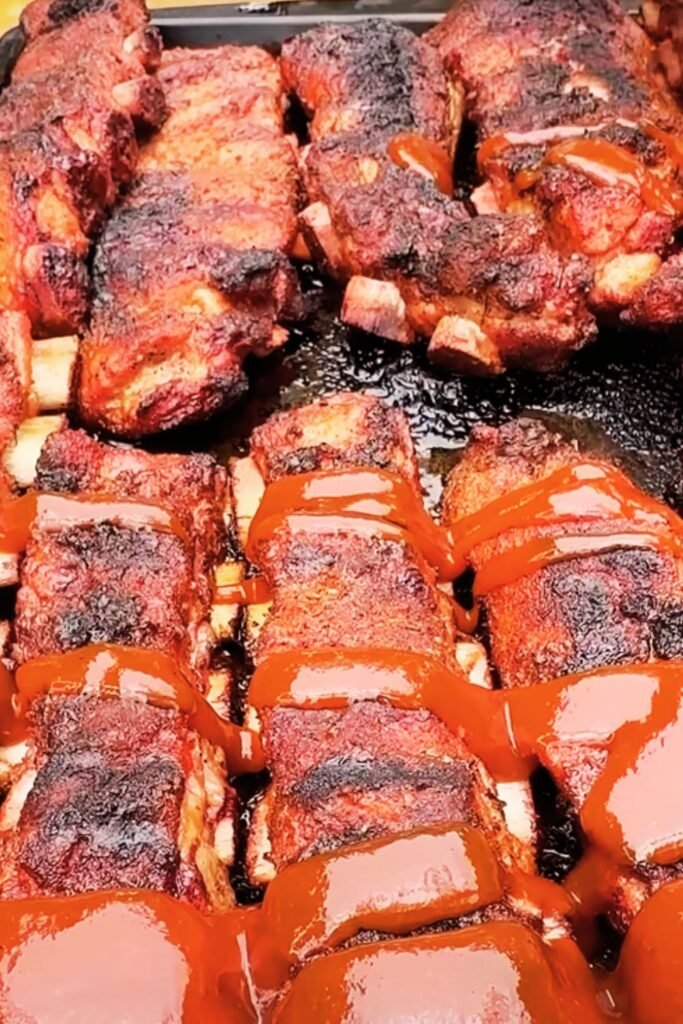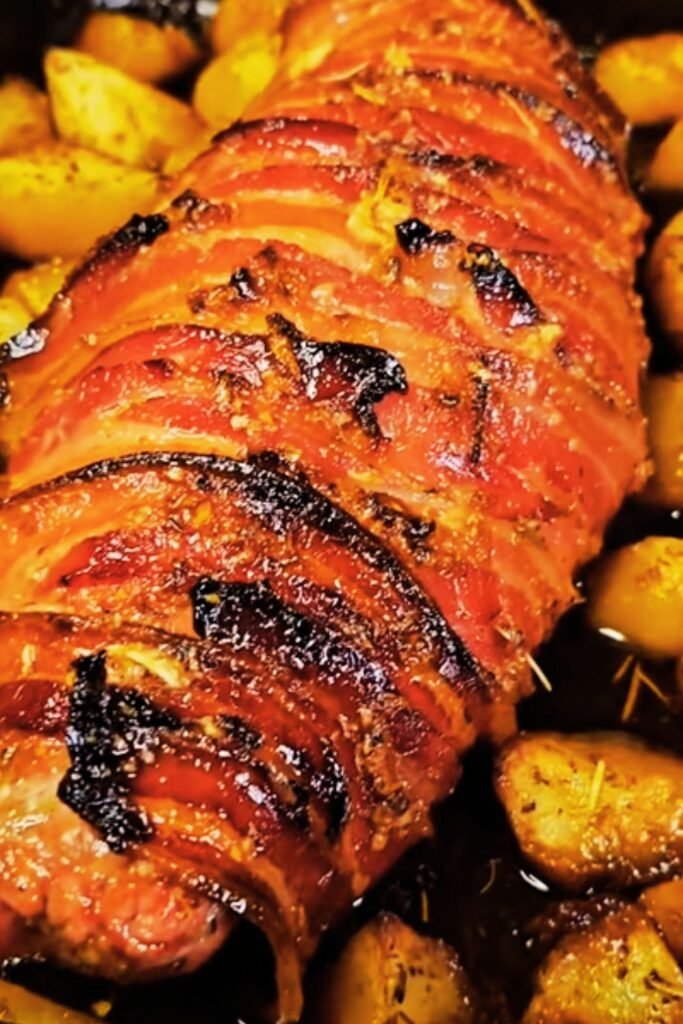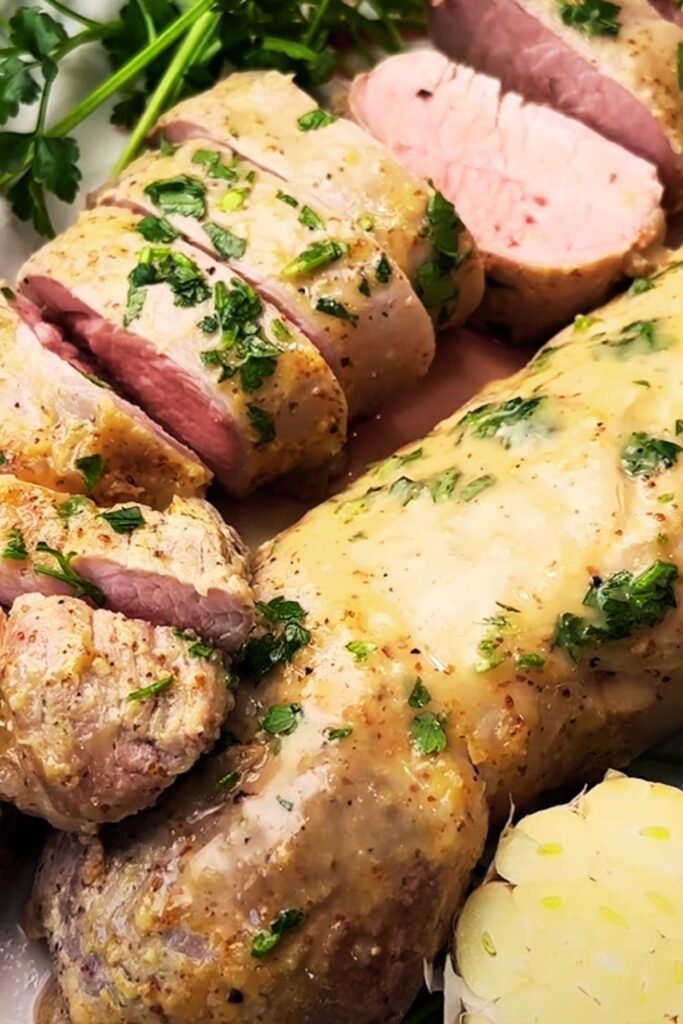When I first attempted to cook pork tenderloin, I was intimidated by its reputation for being either perfectly succulent or disappointingly dry. After years of experimenting and refining my technique, I’ve discovered that oven-baked pork tenderloin can be one of the most rewarding dishes to master. This lean, versatile cut transforms into a restaurant-quality meal when prepared with the right approach.
Pork tenderloin stands out as one of the leanest cuts of pork available, containing less fat than many chicken cuts. My journey with this protein began during a dinner party where I needed to serve something elegant yet approachable. The result was so impressive that guests still ask for the recipe years later.
Understanding Pork Tenderloin: The Foundation of Success
Pork Tenderloin: A cylindrical muscle that runs along the backbone of the pig, typically weighing between 1-1.5 pounds per piece. This cut contains minimal connective tissue and very little marbling.
Internal Temperature: The safe minimum internal temperature for pork is 145°F (63°C), followed by a three-minute rest period.
Trimming: The process of removing the thin, silvery membrane (silverskin) that covers portions of the tenderloin.
Searing: A high-heat cooking technique that creates a flavorful crust on the meat’s surface before finishing in the oven.
The key to exceptional pork tenderloin lies in understanding its lean nature. Unlike fattier cuts that forgive overcooking, tenderloin demands precision. I’ve learned that respecting this cut’s characteristics rather than fighting them leads to consistently excellent results.
Essential Ingredients and Equipment
Core Ingredients
My go-to pork tenderloin recipe relies on simple, high-quality ingredients that enhance rather than mask the meat’s natural flavor:
- 2 pork tenderloins (approximately 1 pound each)
- 3 tablespoons olive oil
- 2 teaspoons kosher salt
- 1 teaspoon freshly ground black pepper
- 2 teaspoons garlic powder
- 1 teaspoon dried thyme
- 1 teaspoon paprika
- ½ teaspoon onion powder
Equipment Requirements
Cast Iron Skillet: My preferred choice for searing, as it retains heat exceptionally well and transitions seamlessly from stovetop to oven.
Meat Thermometer: An instant-read thermometer eliminates guesswork and ensures perfect doneness every time.
Sharp Knife: Essential for proper trimming and achieving clean, even slices when serving.
Cutting Board: A large, stable surface for prep work and resting the cooked meat.
Preparation: Setting the Stage for Success
Trimming the Tenderloin
I always begin by examining each tenderloin carefully. The silverskin, a tough membrane that won’t break down during cooking, must be removed. Using a sharp knife, I slide the blade under one end of the silverskin, then angle it slightly upward while pulling the membrane taut with my other hand. This technique removes the silverskin in long strips without wasting meat.
Creating the Perfect Seasoning Blend
My signature seasoning combines common spices in proportions that complement pork’s mild flavor. I mix the salt, pepper, garlic powder, thyme, paprika, and onion powder in a small bowl, ensuring even distribution. This blend creates a aromatic crust while penetrating the meat’s surface.

The Marination Process
While not strictly necessary, I often let seasoned tenderloins rest at room temperature for 30-45 minutes before cooking. This brief period allows the salt to begin drawing out moisture, which then dissolves the salt and carries flavors back into the meat. The tenderloins also reach closer to room temperature, promoting even cooking.
The Cooking Process: Technique Meets Timing
Searing: Building Flavor Through Heat
I preheat my oven to 425°F (220°C) while heating a cast iron skillet over medium-high heat. Once the pan is hot, I add the olive oil and immediately place the seasoned tenderloins in the skillet. The searing process takes approximately 2-3 minutes per side, creating a golden-brown crust that locks in juices and develops complex flavors.
The sound is my guide during searing. A vigorous sizzle indicates proper heat, while silence suggests the pan isn’t hot enough. I resist the urge to move the meat too quickly, allowing each surface to develop its crust fully.
Oven Finishing: Gentle Heat for Even Cooking
After searing all surfaces, I transfer the skillet directly to the preheated oven. This technique eliminates the need to transfer the meat to another pan, reducing cleanup while maintaining the cooking momentum established during searing.
The oven’s dry heat continues cooking the tenderloin gently and evenly. I typically check the internal temperature after 10-12 minutes, though cooking time varies based on the tenderloin’s thickness and starting temperature.
Temperature Guide and Timing
| Doneness Level | Internal Temperature | Cooking Time (after searing) | Appearance |
|---|---|---|---|
| Medium-Rare | 140°F (60°C) | 8-10 minutes | Slightly pink center |
| Medium | 145°F (63°C) | 10-12 minutes | Barely pink center |
| Medium-Well | 150°F (66°C) | 12-14 minutes | No pink, very juicy |
| Well-Done | 160°F (71°C) | 14-16 minutes | No pink, firm texture |
I consistently aim for 145°F internal temperature, which yields perfectly juicy results with a slight blush of pink. The carryover cooking during the rest period typically raises the temperature by 5-10 degrees.

The Critical Rest Period
Once the tenderloin reaches the target temperature, I remove it from the oven and tent it loosely with aluminum foil. This rest period, lasting 5-10 minutes, allows the meat’s fibers to relax and reabsorb the juices that were driven toward the center during cooking.
I learned the importance of this step through trial and error. Early attempts at slicing immediately after cooking resulted in juices flowing onto the cutting board instead of staying in the meat. The rest period transforms good pork tenderloin into exceptional pork tenderloin.
Slicing Techniques for Optimal Presentation
Proper slicing technique significantly impacts both presentation and eating experience. I use a sharp knife to cut the tenderloin into medallions approximately ¾-inch thick, slicing against the grain at a slight diagonal. This angle creates larger surface areas and more elegant presentation.
The grain in pork tenderloin runs lengthwise, so cutting perpendicular to this direction ensures tender bites. I arrange the slices on a warm platter, slightly overlapping each piece to showcase the perfect pink interior.
Flavor Variations and Seasoning Options
Mediterranean Herb Crust
My Mediterranean variation incorporates dried oregano, rosemary, and a touch of lemon zest into the basic seasoning blend. This combination pairs beautifully with roasted vegetables and creates an aromatic crust that transports diners to coastal Europe.
Asian-Inspired Marinade
For an Asian twist, I create a marinade combining soy sauce, rice wine vinegar, fresh ginger, and a touch of sesame oil. The tenderloin marinates for 2-4 hours, developing deep, umami-rich flavors that complement the meat’s natural sweetness.
Southwestern Spice Rub
My Southwestern blend features chili powder, cumin, smoked paprika, and a hint of cayenne. This combination creates a subtle heat that builds gradually, making it suitable for various spice tolerances.
Nutritional Profile and Health Benefits
| Nutrient | Amount per 4 oz serving | % Daily Value |
|---|---|---|
| Calories | 185 | – |
| Protein | 35g | 70% |
| Total Fat | 4.5g | 7% |
| Saturated Fat | 1.5g | 8% |
| Cholesterol | 95mg | 32% |
| Sodium | 75mg | 3% |
| Iron | 1.5mg | 8% |
| Potassium | 500mg | 14% |
Pork tenderloin ranks among the leanest protein sources available, containing less fat than many cuts of chicken. Its high protein content supports muscle maintenance and growth, while providing essential amino acids necessary for various bodily functions.
The selenium content in pork tenderloin supports immune function and acts as an antioxidant. Additionally, the B-vitamins present, particularly thiamine and niacin, play crucial roles in energy metabolism and nervous system function.
Serving Suggestions and Accompaniments
Classic Pairings
I frequently serve pork tenderloin alongside roasted root vegetables such as carrots, parsnips, and fingerling potatoes. These vegetables can roast in the same oven while the meat cooks, creating a complete meal with minimal effort.
Steamed or sautéed green vegetables provide color contrast and nutritional balance. Asparagus, green beans, or Brussels sprouts work particularly well, offering textural variety and complementary flavors.
Sauce Options
Pan Gravy: I often create a simple pan gravy using the drippings from the cast iron skillet. A splash of chicken broth and a touch of cream create a rich sauce that enhances the pork without overwhelming it.
Apple Chutney: The natural affinity between pork and apples shines in a homemade chutney featuring diced apples, onions, and warm spices like cinnamon and ginger.
Mustard Cream Sauce: Dijon mustard combined with heavy cream and fresh herbs creates an elegant sauce that pairs beautifully with the mild pork flavor.

Storage and Reheating Guidelines
Refrigeration
Cooked pork tenderloin maintains quality in the refrigerator for 3-4 days when stored properly. I slice only what I plan to serve immediately, keeping the remainder whole to minimize surface area exposure to air.
Freezing
For longer storage, pork tenderloin freezes well for up to 3 months. I wrap individual portions tightly in plastic wrap, then place them in freezer bags with dates clearly marked.
Reheating Techniques
Oven Method: I reheat sliced tenderloin in a 325°F oven, covered with foil and a splash of broth to maintain moisture. This gentle approach prevents overcooking while ensuring food safety.
Skillet Method: For quick reheating, a covered skillet over low heat with a small amount of liquid works effectively for individual portions.
Troubleshooting Common Issues
Dry Tenderloin
Overcooking remains the primary cause of dry pork tenderloin. I always rely on a meat thermometer rather than cooking times alone, as individual tenderloins vary in size and starting temperature.
Uneven Cooking
Tenderloins with significantly different thicknesses cook unevenly. I sometimes pound thicker sections gently to create more uniform thickness, or I fold under the thin tail end and secure it with kitchen twine.
Lack of Flavor
Under-seasoning disappoints more than over-seasoning when it comes to pork tenderloin. I’m generous with my seasoning blend, ensuring complete coverage of all surfaces.
Advanced Techniques for the Ambitious Cook
Reverse Searing
For ultimate control, I sometimes employ reverse searing, starting the seasoned tenderloin in a low oven (275°F) until it nearly reaches target temperature, then finishing with a high-heat sear in a cast iron skillet.
Bacon Wrapping
Wrapping the tenderloin in bacon adds fat and flavor while creating an impressive presentation. I secure the bacon with toothpicks and adjust cooking time slightly to ensure the bacon crisps properly.
Stuffing Techniques
Creating a pocket in the tenderloin allows for creative stuffing options. Spinach and feta, sun-dried tomatoes and goat cheese, or traditional bread stuffing all work beautifully.
Cost Analysis and Value
| Comparison Item | Price per pound | Protein per dollar | Preparation time |
|---|---|---|---|
| Pork Tenderloin | $8-12 | High | 30 minutes |
| Beef Tenderloin | $20-30 | Medium | 45 minutes |
| Chicken Breast | $4-6 | High | 25 minutes |
| Salmon Fillet | $12-18 | Medium | 20 minutes |
While pork tenderloin costs more per pound than some proteins, its lean nature means less waste and higher protein density. The relatively quick cooking time and minimal preparation requirements add to its value proposition.
Seasonal Considerations and Menu Planning
Spring Menus
During spring, I pair pork tenderloin with early vegetables like asparagus, peas, and new potatoes. Fresh herb sauces featuring parsley, chives, and tarragon complement the season’s fresh flavors.
Summer Preparations
Summer calls for lighter preparations and cooler serving temperatures. I often serve sliced tenderloin at room temperature over mixed greens with a vinaigrette, creating an elegant warm-weather entrée.
Fall and Winter Comfort
Colder months invite heartier accompaniments like roasted squash, braised cabbage, or creamy polenta. The warming spices in my Southwestern blend work particularly well during these seasons.
Professional Tips from My Kitchen
Through years of cooking pork tenderloin, I’ve developed several techniques that consistently improve results:
Temperature Monitoring: I insert the thermometer into the thickest part of the tenderloin, avoiding fat pockets or the very end where readings might be inaccurate.
Multiple Tenderloin Cooking: When cooking several tenderloins simultaneously, I arrange them with space between each piece to ensure even heat circulation.
Resting Surface: I rest cooked tenderloin on a wire rack set over a sheet pan, allowing air circulation on all sides while catching any drippings for sauce-making.
Seasoning Timing: For deeper flavor penetration, I apply the seasoning blend up to 24 hours in advance, storing the seasoned meat covered in the refrigerator.
Questions and Answers
Q: How do I know when my pork tenderloin is perfectly cooked?
The only reliable method is using an instant-read thermometer inserted into the thickest part of the meat. I aim for 145°F internal temperature, which provides the perfect balance of safety and juiciness. The meat should feel firm but still give slightly when pressed.
Q: Can I cook pork tenderloin from frozen?
While possible, I don’t recommend cooking frozen tenderloin as it leads to uneven cooking. The exterior may overcook while the center remains undercooked. I always thaw completely in the refrigerator, which typically takes 12-24 hours depending on size.
Q: Why does my pork tenderloin turn out dry despite following the recipe?
Overcooking is the most common culprit. Pork tenderloin continues cooking from residual heat even after removing from the oven, so I remove it when it reaches 140-142°F and let carryover cooking bring it to 145°F during the rest period.
Q: Should I brine pork tenderloin before cooking?
Brining isn’t necessary for tenderloin due to its naturally tender texture, but it can add flavor and insurance against overcooking. If I choose to brine, I use a simple solution of water, salt, and sugar for 2-4 hours maximum.
Q: How can I add more flavor to my pork tenderloin?
Beyond seasoning rubs, I create flavor through searing, which develops complex tastes through the Maillard reaction. Marinades, herb crusts, and compound butters also enhance flavor significantly.
Q: What’s the best way to slice pork tenderloin for serving?
I slice against the grain at a slight diagonal, creating medallions about ¾-inch thick. This technique shortens muscle fibers for tenderness while creating attractive presentation pieces.
Q: Can I prepare pork tenderloin ahead of time for entertaining?
Absolutely! I often sear the tenderloin earlier in the day, then finish it in the oven just before serving. The seasoned raw tenderloin can also be prepared up to 24 hours in advance and stored covered in the refrigerator.
Q: What vegetables pair best with oven-baked pork tenderloin?
Root vegetables like carrots, potatoes, and parsnips roast beautifully alongside the pork. Green vegetables such as asparagus, green beans, or Brussels sprouts provide color and nutritional balance. I often choose vegetables that complement my seasoning choices.
Q: How do I prevent my pork tenderloin from sticking to the pan?
Proper pan temperature is crucial. I heat the skillet until a drop of water sizzles and evaporates quickly, then add oil just before the meat. The protein will release naturally when properly seared, so I avoid moving it too early.
Q: Is it safe to eat pork tenderloin with a slight pink color?
Yes, when cooked to 145°F internal temperature, pork can safely retain a slight pink color. This temperature ensures food safety while maintaining optimal juiciness and flavor. The pink color comes from myoglobin, not undercooking.
This comprehensive approach to oven-baked pork tenderloin has transformed my cooking and impressed countless dinner guests. The technique combines simplicity with precision, creating consistently excellent results that showcase this exceptional cut of meat. Whether preparing a weeknight dinner or entertaining guests, mastering pork tenderloin opens doors to elegant, satisfying meals that never disappoint.